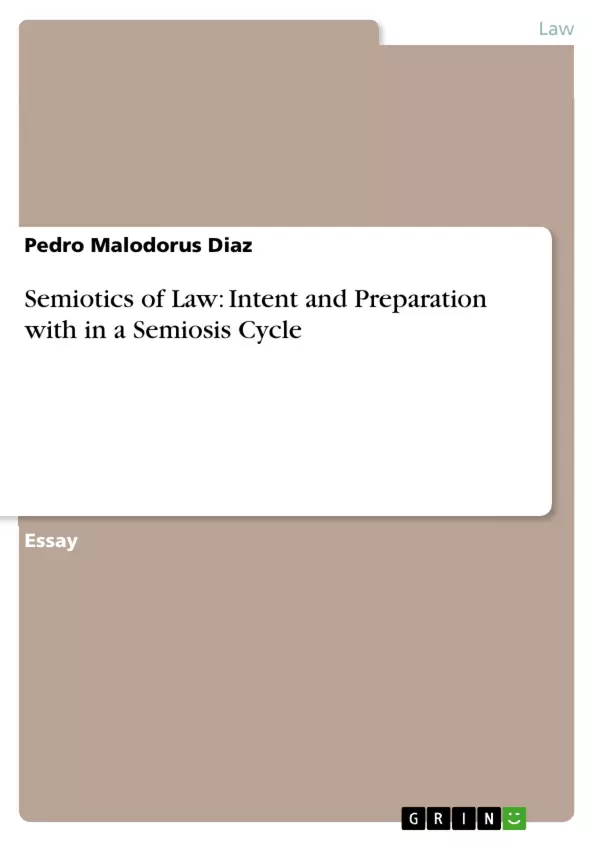This paper examines the legal impossibility that exists when Law Enforcement introduces evidence of a violation of law. Where Law enforcement creates hyper-real entities and uses these entities as actual real victims to prosecute cases involving computer crimes. The courts, prosecutors and juries fail to understand that a symbolic character across the computational medium, the umwelt is not and cannot ever become real simply because law enforcement claims so.
Reality can only exist within the realm where we as humans exist. Hyper-reality remains at a realm that only our minds can imagine. The umwelt is that area that buffers reality from hyper-reality. Television exemplifies this argument, a person watching television can only become so involved with his/her favorite show and no matter how involved the person is - it can never cross that medium that separates them from that show. The Hypothetical Detective claiming to have understood the intentions of the suspect across that medium is only deceiving himself.
Umberto Eco has been quoted as saying…”The battle for survival as a responsible human in the communication era is not to be won where communication begins, but where it ends. When Law enforcement takes it upon itself to ensnare an individual and fails to define full intent and preparation within the semiosis cycle it becomes a legal impossibility.
Inhaltsverzeichnis (Table of Contents)
- Introduction
- Abstract
- Legal Impossibility
- Semiotics is a broad cross disciplinary work
- Reality in an umwelt
Zielsetzung und Themenschwerpunkte (Objectives and Key Themes)
This paper aims to examine the legal impossibility of using evidence created by law enforcement in cases involving computer crimes. The author argues that the courts and juries fail to understand the distinction between reality and hyper-reality, leading to incorrect legal conclusions.- The distinction between reality and hyper-reality in the context of computer crimes
- The role of semiotics in understanding the nature of signs and symbols in digital environments
- The legal implications of creating hyper-real entities in online investigations
- The limitations of juries in understanding the complexities of computational semiotics
- The importance of accurately identifying and representing information in the "umwelt" to ensure proper legal judgment
Zusammenfassung der Kapitel (Chapter Summaries)
Introduction
The introduction sets the stage for the paper by introducing the problem of law enforcement creating hyper-real entities in computer crime cases. The author argues that these entities are not real and cannot be used as evidence in court.Abstract
The abstract summarizes the key arguments of the paper, highlighting the issue of referential fallacy and the legal impossibility of proving intent and preparation in online crimes.Legal Impossibility
This section provides a hypothetical scenario involving a technologist accused of soliciting a minor online. The author uses this case to illustrate the flaws in the legal system's understanding of digital environments and the difficulty in separating reality from hyper-reality.Semiotics is a broad cross disciplinary work
This section discusses the concept of semiotics and how it applies to the digital realm. The author emphasizes the importance of understanding how meaning is created and conveyed in online environments.Reality in an umwelt
The final section delves deeper into the concept of the "umwelt" and the challenges of accurately identifying and representing information in a digital environment. The author argues that the legal system needs to better understand the complexities of semiotics in order to make fair and just judgments in cases involving computer crimes.Schlüsselwörter (Keywords)
This paper explores the intersection of law, technology, and semiotics. Key concepts include the nature of reality and hyper-reality, the role of semiotics in understanding digital environments, the legal implications of creating hyper-real entities in online investigations, the limitations of juries in understanding computational semiotics, and the importance of accurate information representation in the "umwelt."- Citation du texte
- Pedro Malodorus Diaz (Auteur), 2010, Semiotics of Law: Intent and Preparation with in a Semiosis Cycle, Munich, GRIN Verlag, https://www.grin.com/document/204378



